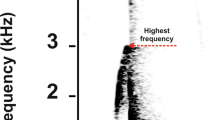Abstract
The slow loris (Nycticebus coucang) is an Asian prosimian for which no data on vocalizations other than verbal description have been provided. Five different calls have been previously reported: a “growl” or “chatter” that the loris emits when disturbed, a “squeak,” a “quaink,” a “whistle,” and an infant click call. Calls were recorded from nine different slow lorises that were being observed in the course of another study. Vocalizations were correlated with the behavior of the calling animal as well as the behavior of its cagemate(s). A variety of methods was used to elicit sounds which were then recorded; sonagrams were made from recordings. Four types of calls were identified. They correspond to all but the quaink and the squeak calls noted above. The pant-growl’s intensity was directly proportional to the degree of disturbance exhibited by the vocalizing animal. The chitter was heard during fights or when an animal was extremely disturbed. The whistle was heard when a female was in estrus. Infant click calls, a series of high-frequency pulses, were made when the infant was separated from its mother. The four calls recorded in the present study may represent only two types: the pant-growl and chitter have similar components and appear to be parts of a graded series of vocalizations that may be derived developmentally from the infant click call; the second type, the whistle call, may be unique to an estrous for courting) animal. The vocal repertoire ofN. coucang compares in size, type, and behavioral context to those of other lorisid prosimians.
Similar content being viewed by others
References
Andrew, R. J. (1963). The origin and evolution of the calls and facial expressions of the primates.Behaviour 20: 1–109.
Butterfield, R. S. (1954). The slow loris as a pet.Malay Nature J. 9: 43–49.
Charles-Dominique, P. (1977).Ecology and Behavior of Nocturnal Primates, Columbia University Press, New York.
Daschbach, N. J., Schein, M. W., and Haines, D. E. (1982). Behavioral effects of cage size on the slow loris (Nycticebus coucang).Applied Anim. Ethol. (in press).
Doyle, G. A., and Martin, R. D. (1974). The behaviour of nocturnal prosimians. In Martin, R. D., Doyle, G. A., and Walker, A. C. (eds.),Prosimian Biology, Duckworth, London.
Ehrlich, A. (1974). Infant development in two prosimian species: Greater bushbaby and slow loris.Dev. Psychobiol. 7: 439–454.
Ehrlich, A., and Musicant, A. E. (1977). Social and individual behaviours in captive slow lorises.Behaviour 60: 195–220.
Heffner, H., and Masterton, B. (1970). Hearing in primitive primates: Slow loris (Nycticebus coucang) and potto (Perodicticus potto).J. Comp. Physiol. Psychol. 71: 175–182.
Marier, P. (1965). Communication in monkeys and apes. In DeVore, I. (ed.),Primate Behavior, Holt, Rinehart and Winston, New York.
Marier, P., and Hamilton, W. J. (1967).Mechanisms of Animal Behavior, Wiley and Sons, New York.
Tenaza, R., Ross, B. A., Tanticharoenyos, P., and Berkson, G. (1969). Individual behaviour and activity patterns of captive slow lorises.Anim. Behav. 17: 664–669.
Author information
Authors and Affiliations
Rights and permissions
About this article
Cite this article
Daschbach, N.J., Schein, M.W. & Haines, D.E. Vocalizations of the Slow Loris,Nycticebus coucang (Primates, Lorisidae). Int J Primatol 2, 71–80 (1981). https://doi.org/10.1007/BF02692301
Received:
Revised:
Issue Date:
DOI: https://doi.org/10.1007/BF02692301




